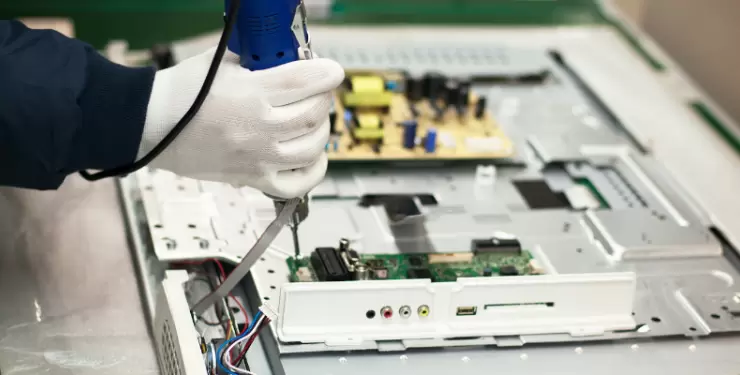The electronics industry is one of the most dynamic and rapidly evolving sectors globally. With the advent of advanced technologies like AI, IoT, and 5G, staying competitive has become a complex endeavor for companies. Every innovation presents new opportunities but also significant challenges. To thrive in this competitive environment, businesses must continuously adapt, innovate, and overcome hurdles that could hinder growth. Here, we will explore some key challenges faced by the electronics sector and how companies can navigate these obstacles to remain competitive.
1. Rapid Technological Advancements: The Need for Constant Innovation
Technology in the electronics sector evolves at an extraordinary pace, forcing companies to innovate constantly. The pressure to release new and improved products, from smartphones to wearables and semiconductors, is relentless. Companies that cannot keep up risk becoming obsolete.
How to Overcome:
- Invest in R&D: To stay relevant, companies must invest heavily in research and development to create groundbreaking products and anticipate market needs. Collaborations with academic institutions and other tech companies can also foster innovation.
- Agility in Product Development: Reducing the time-to-market cycle is crucial. Companies should adopt agile development processes, enabling them to release new products faster and pivot quickly in response to market trends.
2. Supply Chain Disruptions: Navigating Global Complexities
The global electronics supply chain is intricate and heavily reliant on various international partners. Any disruption—be it due to geopolitical tensions, natural disasters, or pandemics—can have severe impacts on production and distribution.
How to Overcome:
- Diversify Suppliers: Relying on a single supplier or region can be risky. Companies should diversify their supplier base to mitigate risks associated with localized disruptions.
- Invest in Supply Chain Technology: Implementing AI and blockchain technology can improve supply chain visibility, predict potential disruptions, and streamline operations.
3. Talent Shortages: Competing for Skilled Labor
As new technologies emerge, the demand for specialized skills in fields like AI, machine learning, and embedded systems continues to rise. However, there is a significant talent gap, and companies face stiff competition in hiring skilled professionals.
How to Overcome:
- Develop Talent In-House: Companies can address the talent gap by investing in employee training and development programs, helping to upskill existing employees to meet new technological demands.
- Collaborate with Educational Institutions: Partnering with universities and technical schools to develop industry-focused programs ensures a steady pipeline of skilled professionals.
4. Sustainability and Environmental Regulations: Adapting to Green Demands
Sustainability has become a central concern in the electronics sector, both from a regulatory perspective and due to consumer demand for eco-friendly products. Companies are increasingly being held accountable for the environmental impact of their products, from manufacturing to disposal.
How to Overcome:
- Adopt Circular Economy Practices: Implementing a circular economy model by reusing and recycling materials can reduce waste and lower production costs.
- Focus on Energy Efficiency: Developing energy-efficient products not only aligns with environmental regulations but also resonates with eco-conscious consumers.
5. Intellectual Property (IP) Theft: Protecting Innovations
With the race to innovate, companies are increasingly vulnerable to IP theft, particularly in regions where enforcement of IP laws is weak. Losing proprietary technology or designs can cripple a company’s ability to compete.
How to Overcome:
- Strengthen IP Protections: Companies must proactively secure their intellectual property by filing patents in key markets and working with legal experts to safeguard their innovations.
- Leverage AI for IP Monitoring: Advanced AI tools can help monitor potential infringements and alert companies to IP violations across global markets.
6. Shifting Consumer Preferences: The Power of Customization
Consumer preferences in electronics are shifting toward more personalized and customizable products. From smartphones to home appliances, customers now expect devices tailored to their specific needs and lifestyles.
How to Overcome:
- Embrace Customer-Centric Design: Companies that prioritize customer feedback and incorporate it into product development will gain a competitive edge. Offering customizable options allows businesses to meet diverse consumer demands.
- Utilize Data Analytics: Leveraging big data and AI to analyze consumer behavior can help companies anticipate trends and create products that align with evolving preferences.
7. Cost Pressures: Balancing Innovation with Profitability
The demand for cutting-edge technology often comes with high production costs, while consumers simultaneously seek affordable electronics. Striking a balance between innovation and profitability is a constant challenge.
How to Overcome:
- Optimize Manufacturing Processes: Investing in automation, AI, and robotics can reduce production costs and improve efficiency.
- Explore Strategic Partnerships: Partnering with other tech firms for joint ventures can reduce costs, share risks, and lead to mutual innovations.
8. Regulatory Compliance: Meeting Global Standards
As electronics products are traded across borders, companies must navigate a maze of global regulations concerning safety standards, privacy laws, and trade restrictions. Failing to comply with these regulations can lead to costly penalties and delays in product launches.
How to Overcome:
- Stay Informed and Proactive: Companies should stay updated on changing regulations in different regions and incorporate compliance into their development process.
- Invest in Compliance Software: AI-driven regulatory compliance tools can help monitor laws and ensure adherence to global standards.
Final Thoughts
The electronics industry’s fast-paced nature presents both immense opportunities and considerable challenges. To stay ahead, companies must embrace innovation, enhance operational efficiency, and proactively address industry-specific hurdles. By adopting a forward-thinking approach and leveraging emerging technologies like AI, businesses can not only navigate these challenges but thrive in this competitive sector.


